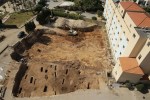 An archaeological survey in advance of new construction in the city of Batroun, about 20 miles north of Byblos on the Mediterranean coast of northern Lebanon, has unearthed an ancient burial ground. Archaeologists from Lebanon’s Directorate General of Antiquities (DGA) found 17 graves with skeletal remains at the site of a planned addition to the San Stephano Resort. Initial osteological examination found the remains of men, women and children.
An archaeological survey in advance of new construction in the city of Batroun, about 20 miles north of Byblos on the Mediterranean coast of northern Lebanon, has unearthed an ancient burial ground. Archaeologists from Lebanon’s Directorate General of Antiquities (DGA) found 17 graves with skeletal remains at the site of a planned addition to the San Stephano Resort. Initial osteological examination found the remains of men, women and children.
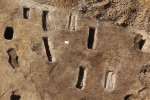 Preliminary estimates date the graveyard to the 2nd or 3rd century A.D., a period when the city prospered under Roman rule. These estimates are based mainly on the type of interrals: coffin burials. The wood has not survived, but the coffin nails have. There are few grave goods — a coin, an iron ring and two modest pieces of Greek pottery from the Hellenistic period — but nothing clearly datable to the Roman period. A Roman-era necropolis was found nearby during construction of the main road, so this may be a continuation of the same burial ground.
Preliminary estimates date the graveyard to the 2nd or 3rd century A.D., a period when the city prospered under Roman rule. These estimates are based mainly on the type of interrals: coffin burials. The wood has not survived, but the coffin nails have. There are few grave goods — a coin, an iron ring and two modest pieces of Greek pottery from the Hellenistic period — but nothing clearly datable to the Roman period. A Roman-era necropolis was found nearby during construction of the main road, so this may be a continuation of the same burial ground.
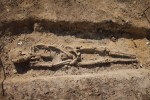 Batroun is one of the most ancient cities in the world, although the date of its founding is ambiguous. Ancient sources appear to differ on the matter, and it’s hard to pin down because the name of the town changes. The city of “Batruna” is mentioned by Rib-Hadda, the king of Gubla (Byblos to the Greeks), in EA 79 of the Amarna letters, a collection of diplomatic correspondence to Pharaoh Akhenaten incised on clay tablets in the 14th century B.C.; some scholars believe this Batruna is Batroun. However, 2nd century B.C. Greek historian Menander of Ephesus is quoted in Flavius Josephus’s Antiquities of the Jews (Book VIII, 13, 2) saying “the city Botrys in Phoenicia” was founded by Ithobaal I of Tyre, the 9th century B.C. Phoenician king whose daughter Jezebel became infamous thanks to the Biblical account of her marriage to Ahab. The Greek name for Batroun is Botrys, Bothrys or Bostrys.
Batroun is one of the most ancient cities in the world, although the date of its founding is ambiguous. Ancient sources appear to differ on the matter, and it’s hard to pin down because the name of the town changes. The city of “Batruna” is mentioned by Rib-Hadda, the king of Gubla (Byblos to the Greeks), in EA 79 of the Amarna letters, a collection of diplomatic correspondence to Pharaoh Akhenaten incised on clay tablets in the 14th century B.C.; some scholars believe this Batruna is Batroun. However, 2nd century B.C. Greek historian Menander of Ephesus is quoted in Flavius Josephus’s Antiquities of the Jews (Book VIII, 13, 2) saying “the city Botrys in Phoenicia” was founded by Ithobaal I of Tyre, the 9th century B.C. Phoenician king whose daughter Jezebel became infamous thanks to the Biblical account of her marriage to Ahab. The Greek name for Batroun is Botrys, Bothrys or Bostrys.
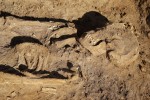 As the Rib-Hadda was appealing to Akhenaten for military aid against the nomadic Apiru or Habiru people who were in league with his enemy Abdi-Ashirta, the Amorite king of Amurru, it’s possible that Amarna-period city of Batruna was sacked and then refounded by Ithobaal in the 9th century. It was subsequently conquered by the Assyrians, Alexander the Great, the Arab Iturean tribes and the Romans. It was part of the Greek Orthodox Patriarchate of Antioch when on July 9th, 551 A.D., it was all but destroyed by a massive earthquake that levelled many Levantine cities. It reappears in the historical record in the 12th century when Crusaders took it from the Emirate of Banu Ammar.
As the Rib-Hadda was appealing to Akhenaten for military aid against the nomadic Apiru or Habiru people who were in league with his enemy Abdi-Ashirta, the Amorite king of Amurru, it’s possible that Amarna-period city of Batruna was sacked and then refounded by Ithobaal in the 9th century. It was subsequently conquered by the Assyrians, Alexander the Great, the Arab Iturean tribes and the Romans. It was part of the Greek Orthodox Patriarchate of Antioch when on July 9th, 551 A.D., it was all but destroyed by a massive earthquake that levelled many Levantine cities. It reappears in the historical record in the 12th century when Crusaders took it from the Emirate of Banu Ammar.
 Whatever the exact date of its founding and gaps in occupation, Batroun is one of the most ancient cities in the world. It has notable archaeological remains from the Phoenician, Hellenistic, Roman and Crusader periods, including a protective sea wall the Phoenicians built by adding masonry to a natural formation of petrified sand dunes. The wall is 740 feet long, the longest Phoenician structure still in existence, and is up to 16 feet high in parts.
Whatever the exact date of its founding and gaps in occupation, Batroun is one of the most ancient cities in the world. It has notable archaeological remains from the Phoenician, Hellenistic, Roman and Crusader periods, including a protective sea wall the Phoenicians built by adding masonry to a natural formation of petrified sand dunes. The wall is 740 feet long, the longest Phoenician structure still in existence, and is up to 16 feet high in parts.
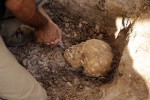 Roman remains include a rock-cut theater which is on private property but is open to the public and irrigation channels, some of which have been integrated into the modern canal system. The earthquake claimed a great deal of the Roman city, so the discovery of the burial ground is highly significant. The remains will be removed to the Directorate General of Antiquities in Beirut for further analysis and study. Radiocarbon dating should confirm the date of this necropolis.
Roman remains include a rock-cut theater which is on private property but is open to the public and irrigation channels, some of which have been integrated into the modern canal system. The earthquake claimed a great deal of the Roman city, so the discovery of the burial ground is highly significant. The remains will be removed to the Directorate General of Antiquities in Beirut for further analysis and study. Radiocarbon dating should confirm the date of this necropolis.
First sentence:
Mediterranean cost?